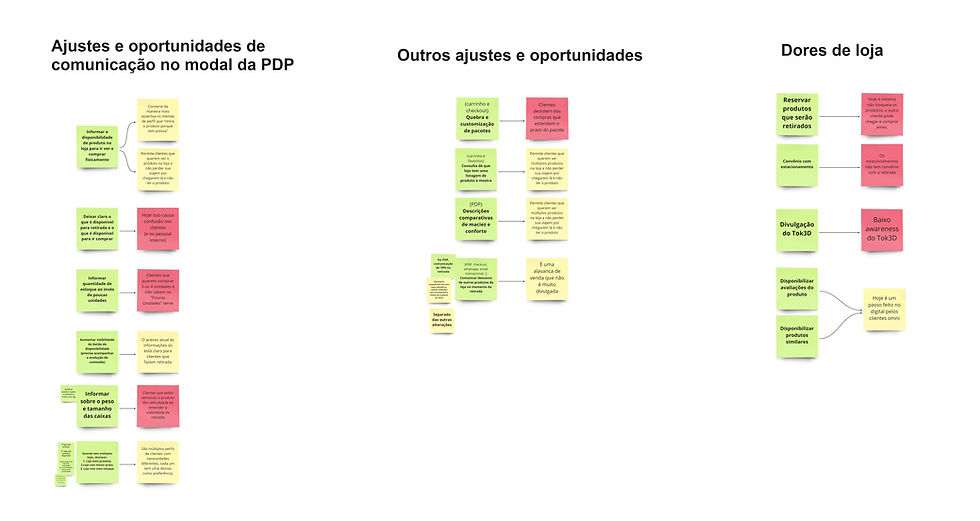
CSD Matrix, Research planning, Survey, A/B Testing
Omni-channel journey
After receiving a ready-made solution from stakeholders of changing the communication in our product page regarding the avaiability of products in the physical stores, a proposal was made back to actually look at what originated the need of this comunication and investigate the pain points of the customers.
Stages /
CSD Matrix
Research planning
A/B Testing
In Depth interviews
User Journey Mapping
Prototyping
Tools /
CSD Matrix (context mapping)
A/B Testing (quantitative)
In Depth interviews (qualitative)
Survey (quantitative)
User Journey Mapping (ideation)
Prototyping
Matrix CSD with Stakeholders
Together with the stakeholders from this projects and personnel from technology, product, design and businness areas related to the theme, we organized our internal knowledge in a matrix separating things we were Certain of, Suppositions and Doubts we had.



Organizing Hypothesis
Having the doubts and supposition columns as a base, it was possible to list hypothesis that would actually guide our research efforts.

Research planning
A research plan was formulated to validate our hypothesis:
For the "information of product avaiability is too hidden and not being found by the users", an A/B testing (quantitative and behavioral) was selected, applying more emphasis to the information on screen and measuring the amounts of clicks in it.
For revising how assertive the information shown actually is, we selected a survey (quantitative and attitudinal) to better understand the grades of importance users give to each piece of information, such as store proximity, product avaiability and so on.
We also stated the necessity of in-depth interviews (qualitative) to understand the reasoning and behaviour of customers particular to an omni-channel purchasing journey.
Before the stage of prototyping, it was planned to draft an User Journey Map, as well as conducting benchmarks.

A/B Testing
The point of entry to the product avaiability information modal is hidden inside the adress field, as a link button.
The experimental version would show the component as an secondary button above the field adress.



In-Depth Interviews
We conducted 5 interviews with customers that used both the digital and physical stores on the same product purchase, and 5 customers that picked up products on store.
The script questions were written as to answer the following research questions:
- What kind of information is sought on the e-commerce?
- What kind of information is sought on the physical store?
- How is a store chosen for visiting?
- What data regarding the physical store is looked up on the e-commerce?
- What is the reasoning behind paying on the physical store or the e-commerce?
- In what steps of the purchasing proccess is made the decision of picking up the product or having it delivered at home?
- What influences the choosing of delivery or pick-up?
The interviews were conducted in a semi structured way, with a series of topics that shoul de discussed in any order instead of an end it all script.
The study took place presentially in the city of São Paulo, and remotelly with customers from other cities and states, as to minimize region bias.









Survey
A survey was made to better understand how important the customers consider each piece of information when choosing a store to visit, such as store proximity, shipping time and item avaiability.
The survey was up as an pop-up window in every product page, and started with a screening question to properly target omni-channel customers.
Through the in depth interviews though, it was possible to notice the existence of several user profiles that prioritized different sets of information that were not considered when the survey was sent. As such, these results were analysed as to understand how these profiles users are distributted quantitatively.




User Journey Map
After the researching stage was concluded, the intermediate results were presented in a checkpoint meeting.




An user journey map was drawn collaboratively, structuring the findings in a visual way, and also ordering them chronologically accordingly to the user's behaviour.
Two sepparate journeys were made. One regarding users with omni channel behaviour, and another one regarding users that purchase online for in store pickup.
Omni-channel user journey map

In store pickup user journey map

Having mapped the user journey, the squad listed the solution requirements that would actually be targetting either the identified pain points or opportunitites, to improve the experience of the service as a whole for these users. Other opportunities for the e-commerce were added to the backlog, and opportunities for the physical store were communicated to the Store squads.

A solution was finally prototyped, using insights from the Research and Ideations steps to properly communicate product avaiability for pickup purchase and for evaluation in a physical store before purchasing.



A usability test was not conducted for this prototype since:
1- A previous version with high degree of similarity had already been approved in an usability test with users;
2- Every keyword has already been used in other pages of the e-commerce, as well as there were no complex interaction in the modal.
Thus we evaluated the solutions as having very low risk regarding usability.